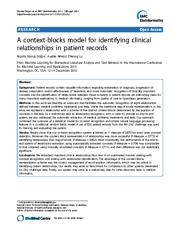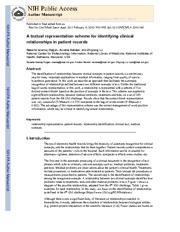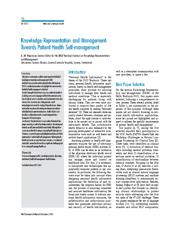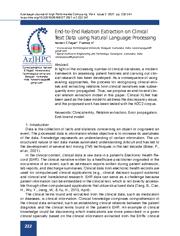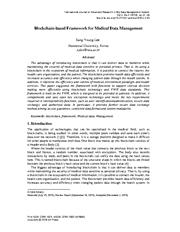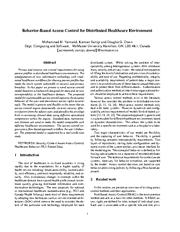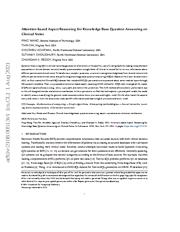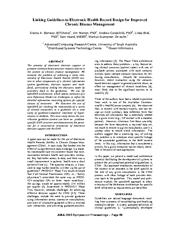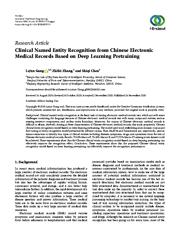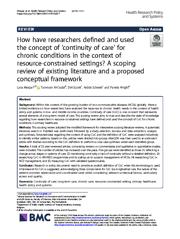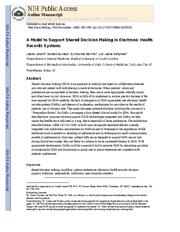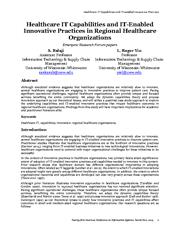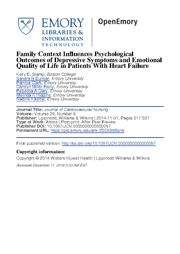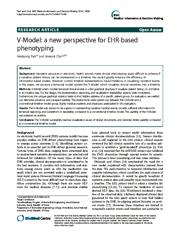A copy of this work was available on the public web and has been preserved in the Wayback Machine. The capture dates from 2017; you can also visit the original URL.
The file type is application/pdf.
Filters
A context-blocks model for identifying clinical relationships in patient records
2011
BMC Bioinformatics
Automatic recognition of clinically important concepts and the identification of relationships between those concepts in patient records are preliminary steps for many important applications in medical ...
A set of 826 patient records from the 4th i2b2 challenge was used for training and evaluating the system. ...
Each relationship model was implemented as a context-blocks model, where all available features were organized according to the specific context blocks their appeared in. ...
doi:10.1186/1471-2105-12-s3-s3
pmid:21658290
pmcid:PMC3111589
fatcat:t4zgqiusbzembbi27434kt5qam
A Textual Representation Scheme for Identifying Clinical Relationships in Patient Records
2010
2010 Ninth International Conference on Machine Learning and Applications
The identification of relationships between clinical concepts in patient records is a preliminary step for many important applications in medical informatics, ranging from quality of care to hypothesis ...
Unlike the traditional bag-of-words representation, in this work, a relationship is represented with a scheme of five distinct context-blocks based on the position of concepts in the text. ...
Such a representation was successful in identifying eight relationships between medical problems, treatments and tests in patient records. ...
doi:10.1109/icmla.2010.164
pmid:21552455
pmcid:PMC3087201
dblp:conf/icmla/DoganNL10
fatcat:q37zptgq6jgsvptpc5na3y63nu
Knowledge Representation and Management: Towards Patient Health Self-management
2012
IMIA Yearbook of Medical Informatics
of medical concepts, assertions and/or relationships from clinical texts. ...
Delivering timely, friendly and secure access to functional, accurate, up-to-date and sustainable personal health records is a significant challenging task for supporting self-managed healthcare. ...
Acknowledgement I greatly acknowledge the support of Martina Hutter and of the reviewers in the selection process of the IMIA Yearbook. ...
doi:10.1055/s-0038-1639442
fatcat:abldijr4hnegjbg7yksrobotby
END-TO-END RELATION EXTRACTION ON CLINICAL TEXT DATA USING NATURAL LANGUAGE PROCESSING
2021
Azerbaijan Journal of High Performance Computing
In light of the increasing number of clinical narratives, a modern framework for assessing patient histories and carrying out clinical research has been developed. ...
Thus, we propose an end-to-end clinical relation extraction model in this paper. ...
In the clinical context, clinical data is raw data in a patient's Electronic Health Record (EHR). ...
doi:10.32010/26166127.2021.4.2.232.241
fatcat:sv2xxtncgfgo5hl4lmnlxqm57a
Blockchain-based Framework for Medical Data Management
2019
International Journal of Advanced Research in Big Data Management System
That is, by using a blockchain in the ecosystem of medical information, it is possible to connect the insurer, the health care organization, and the patient. ...
This paper suggested the framework with functions to support clinical decision making more efficiently using blockchain technology and FHIR data standards. ...
Social Media can identify patients by external identification and patients' records connections or logins through Google, Facebook and open IDs, and logins restrict access to security and patient records ...
doi:10.21742/ijarbms.2019.3.2.05
fatcat:r6qb6t3e6rg37pcyrpxcpji5oe
Behavior-Based Access Control for Distributed Healthcare Environment
2008
2008 21st IEEE International Symposium on Computer-Based Medical Systems
In this paper we present a novel access control model based on a framework designed for data and service interoperability in the healthcare domain. ...
The model is generic and flexible in the sense that an access control engine dynamically receives security effective factors from the subject user, and identifies the privilege level in accessing clinical ...
A clear and accurate representation of security input factors and their inter-relationships are necessary for effective operation of other blocks of the model. ...
doi:10.1109/cbms.2008.14
dblp:conf/cbms/YarmandSD08
fatcat:ukjrpgcwhbay5ntbhbuf77zfcq
Attention-based Aspect Reasoning for Knowledge Base Question Answering on Clinical Notes
[article]
2021
arXiv
pre-print
Existing machine reading comprehension approaches in clinical domain can only handle questions about a single block of clinical texts and fail to retrieve information about different patients and clinical ...
Question Answering (QA) in clinical notes has gained a lot of attention in the past few years. ...
However, their model can only access information from a single block of texts, which is not practical for doctors who may need information from a collection of clinical notes. ...
arXiv:2108.00513v1
fatcat:myywcav4szdq3obalef753veki
Linking guidelines to Electronic Health Record design for improved chronic disease management
2003
AMIA Annual Symposium Proceedings
We illustrate the use of openEHR for tracking the relationship of a series of clinical encounters to a guideline via a case study of guideline-compliant treatment of hypertension in diabetes. ...
We examine the problem of achieving a close relationship of Electronic Health Record (EHR) content to other components of a clinical information system (guidelines, decision support and workflow), particularly ...
ACKNOWLEDGMENT We extend thanks to Thomas Beale, Zar Zar Tun, and Andrea Broglia for their technical contribution to openEHR and their guidance in preparation of this manuscript and prototype development ...
pmid:14728135
pmcid:PMC1480104
fatcat:egiujtumtnh57a3kbeq2735toy
Clinical Named Entity Recognition from Chinese Electronic Medical Records Based on Deep Learning Pretraining
2020
Journal of Healthcare Engineering
Aiming at these characteristics of Chinese electronic medical records, this study proposed a Chinese clinical entity recognition model based on deep learning pretraining. ...
Then BiLSTM and Transformer are, respectively, used as feature extractors to identify four types of clinical entities including diseases, symptoms, drugs, and operations from the text of Chinese electronic ...
A test item is given to a patient in order to discover, deny, confirm, and find out more about the disease. ...
doi:10.1155/2020/8829219
pmid:33299537
pmcid:PMC7707942
fatcat:majkysnbkbgjzaucovyrqpbyyq
How have researchers defined and used the concept of 'continuity of care' for chronic conditions in the context of resource-constrained settings? A scoping review of existing literature and a proposed conceptual framework
2019
Health Research Policy and Systems
A framework for CoC is suggested, acknowledging three components for CoC (i.e. longitudinal care, the nature of the patient-provider relationship and coordinated care) while considering relevant contextual ...
Continuity of care (CoC) is one concept that represents several elements of a long-term model of care. ...
Acknowledgements The authors would like to thank Dima Meiqari for her inputs on the visualisation of the framework. Alison Fisher provided editing assistance. ...
doi:10.1186/s12961-019-0426-1
fatcat:yrvhp5onhfcypal3ddznpeykhu
A Model to Support Shared Decision Making in Electronic Health Records Systems
2014
Medical decision making
Leveraging a four-phased clinical model for SDM, this article describes how computer decision support (CDS) technologies integrated into EHRs can help insure that healthcare is delivered in a way that ...
While additional work is needed on modeling of preferences and on techniques for rapid communication models of preferences to clinicians, unless EHRs are re-designed to support SDM around and during clinical ...
If, customization of the context for standing orders can occur, a provider may be confident enough in their patient relationship and in the clinical context of referral to use automatic delivery decision ...
doi:10.1177/0272989x14550102
pmid:25224366
pmcid:PMC4289635
fatcat:o6wbzf3kfjgyfhkvnudw7ok324
Public Transportation Environment and Medical Choice for Chronic Disease: A Case Study of Gaoyou, China
2019
International Journal of Environmental Research and Public Health
medical supply and demand in each block. ...
There is a lack of in-depth research on medical choice from the perspective of patient demand. ...
In addition, we mainly used medical records to identify patients with chronic diseases. ...
doi:10.3390/ijerph16091612
pmid:31071961
pmcid:PMC6539171
fatcat:rk2ktg6oabexbi64im6xct7d6i
Healthcare IT Capabilities and IT-Enabled Innovative Practices in Regional Healthcare Organizations
2015
Americas Conference on Information Systems
Although anecdotal evidence suggests that healthcare organizations are relatively slow to innovate, several healthcare organizations are engaging in innovative practices to improve patient care. ...
Findings from this study will have important implications for academic and practitioner literature alike. ...
For example, through Building Information Modeling (BIM) 2 systems, a team of various mechanical contractors will work together to identify solutions immediately upon encountering conflicts in a systematic ...
dblp:conf/amcis/Sankaranarayanan15
fatcat:sbk4q5wqjfgafnvuz6abeqyfj4
Family Context Influences Psychological Outcomes of Depressive Symptoms and Emotional Quality of Life in Patients With Heart Failure
2014
Journal of Cardiovascular Nursing
Future interventions could target the modifiable patient-family context relationships for improving depressive symptoms and QOL in HF patients. ...
Background-Although family influences in heart failure (HF) care are considered important, little evidence is available regarding relationships between the family context and specific outcomes for patients ...
Sequential (hierarchical) linear regression was used to build models for assessing the relationships between (block 2) patient perceptions of family context (FAD scales for global family functioning, problem ...
doi:10.1097/jcn.0000000000000097
pmid:24434821
pmcid:PMC4098026
fatcat:pkke7qwk5bbu7nyxdrlhgq6tyq
V-Model: a new perspective for EHR-based phenotyping
2014
BMC Medical Informatics and Decision Making
Methods: V-Model which models temporal clinical events in v-like graphical structure. It visualizes patient history on a timeline in an intuitive way. ...
Narrative resources in electronic health records make clinical phenotyping study difficult to achieve. ...
If a context block is found repetitively in a specific patient group (e.g., a red context block followed by a green one in Figure 5 (a)), the block is recognized as a pattern. ...
doi:10.1186/1472-6947-14-90
pmid:25341558
pmcid:PMC4283133
fatcat:7ab2jdp4qjfhtetbv3khvtmdxy
« Previous
Showing results 1 — 15 out of 93,793 results

